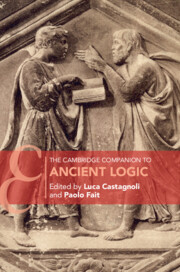Book contents
- The Cambridge Companion to Ancient Logic
- Other Volumes in the Series of Cambridge Companions
- The Cambridge Companion to Ancient Logic
- Copyright page
- Contents
- Contributors
- Introduction
- I The Development of Logic in Antiquity
- II Key Themes
- 5 Truth as a Logical Property and the Laws of Being True
- 6 Definition
- 7 Terms and Propositions
- 8 Validity and Syllogism
- 9 Demonstration
- 10 Modalities and Modal Logic
- 11 Fallacies and Paradoxes
- 12 Logic in Ancient Rhetoric
- 13 Ancient Logic and Ancient Mathematics
- III The Legacy of Ancient Logic
- Bibliography
- Abbreviations
- Index of Passages
- General Index
- Other Volumes in the Series of Cambridge Companions
12 - Logic in Ancient Rhetoric
from II - Key Themes
Published online by Cambridge University Press: 29 April 2023
- The Cambridge Companion to Ancient Logic
- Other Volumes in the Series of Cambridge Companions
- The Cambridge Companion to Ancient Logic
- Copyright page
- Contents
- Contributors
- Introduction
- I The Development of Logic in Antiquity
- II Key Themes
- 5 Truth as a Logical Property and the Laws of Being True
- 6 Definition
- 7 Terms and Propositions
- 8 Validity and Syllogism
- 9 Demonstration
- 10 Modalities and Modal Logic
- 11 Fallacies and Paradoxes
- 12 Logic in Ancient Rhetoric
- 13 Ancient Logic and Ancient Mathematics
- III The Legacy of Ancient Logic
- Bibliography
- Abbreviations
- Index of Passages
- General Index
- Other Volumes in the Series of Cambridge Companions
Summary
Early Greek rhetoricians dealt with a wide range of persuasive techniques: emotional appeals, stylistic ornamentation, slander, and eristic tricks were all part of their repertoire. Notwithstanding this variety, there was a basic understanding that any technique of persuasion has to incorporate elements of genuine argumentation. This is why even early systems of rhetoric came to acknowledge the relevance of notions like proof, sign, probability, contrariety, etc. Still, Aristotle was the first to conceive rhetoric as an endeavour that essentially relies on arguments and, thus, requires some expertise in logic. He strikingly requires the rhetorician, who has to deal with rhetorical proofs or arguments, to be an expert in all sorts of sullogismos, or deductive argument. At the time Aristotle wrote the core of his Art of Rhetoric, he seems to have taken for granted that it is the dialectician who is the expert on all sorts of sullogismoi. The logic that he thus adopts for his account of rhetorical arguments seems to be the same logic that underlies his dialectic, which is unfolded in his Topics and Sophistical Refutations. The underlying logic of these works includes a clear understanding of deductive arguments, the difference between deductive and inductive arguments, and the role of premises, conclusions, and refutations. Most notably, it introduces the so-called topoi, argumentative schemes that enable the dialectician to construct premises from which he can derive the intended conclusion.1 These are the most important tools that Aristotle uses for reinterpreting the terminology of the traditional rhetorical manuals. For example, he takes over the traditional notion of an enthymeme, which had previously been used for condensed and antithetical formulations (see Section II below), and redefines it as a sullogismos that is used for rhetorical purposes. He also tries to adapt the sullogismos as it was defined and used in dialectic to the peculiar circumstances of a public speech, taking into account, for example, that the mostly contingent and variable subject matter of rhetorical arguments seldom allows for necessary proofs. This insight brings the role of the sullogismos, in certain cases, close to the role of the likelihoods and probability arguments, which were prominent in early rhetoric; but, unlike his predecessors, Aristotle is able to clearly distinguish between the modal quality of a premise and the (logical) necessity of a conclusion. Equipped with these logical distinctions he reinterprets the use of likelihoods in traditional rhetoric as a modal modification of the premises of a rhetorical sullogismos.
- Type
- Chapter
- Information
- The Cambridge Companion to Ancient Logic , pp. 263 - 282Publisher: Cambridge University PressPrint publication year: 2023



